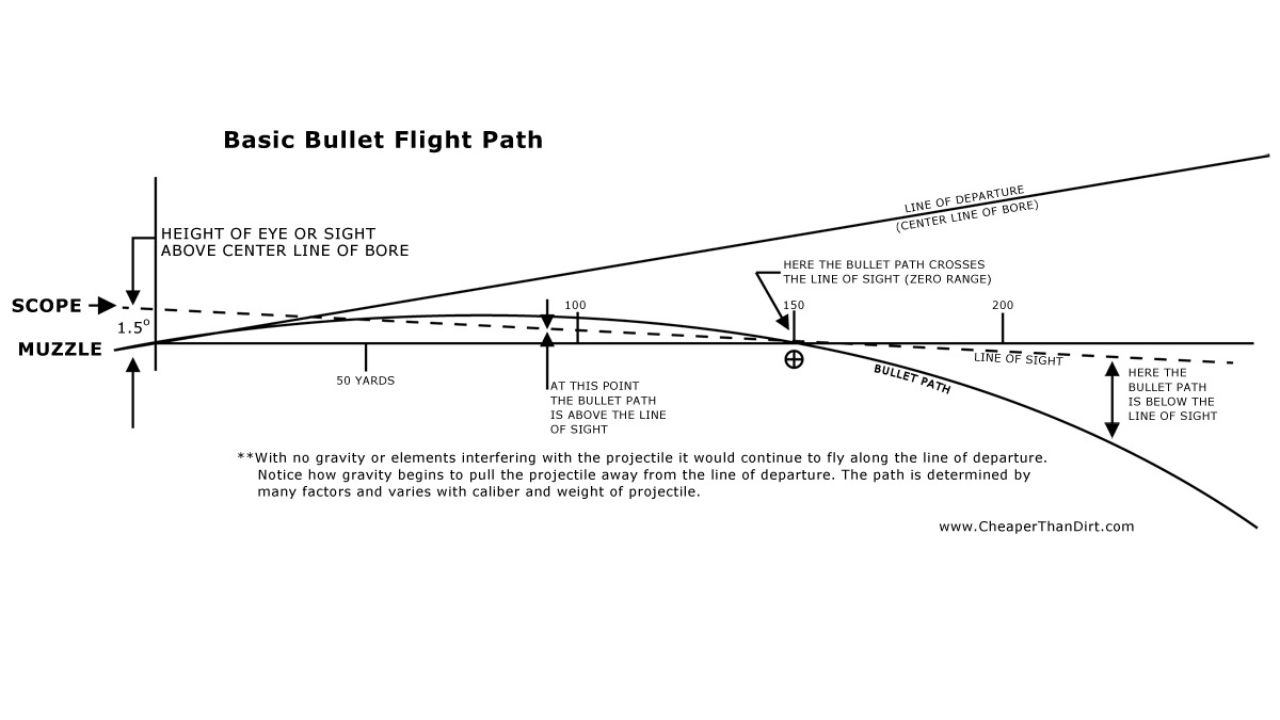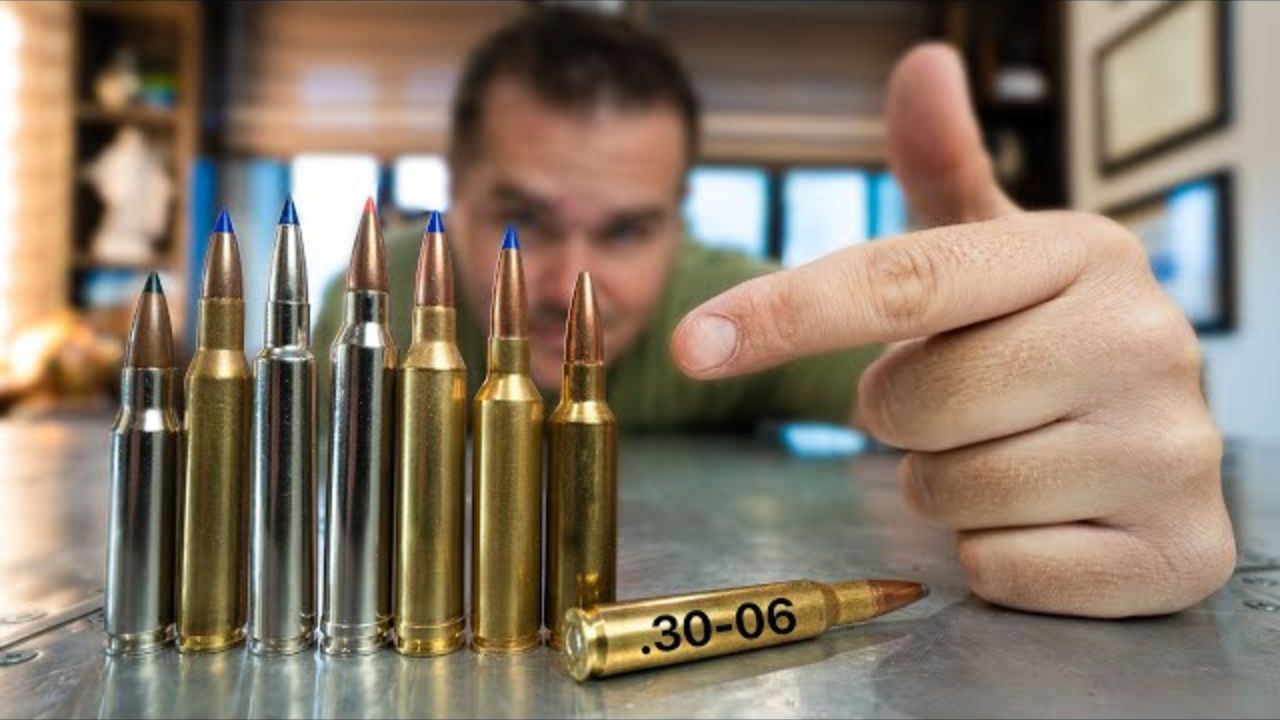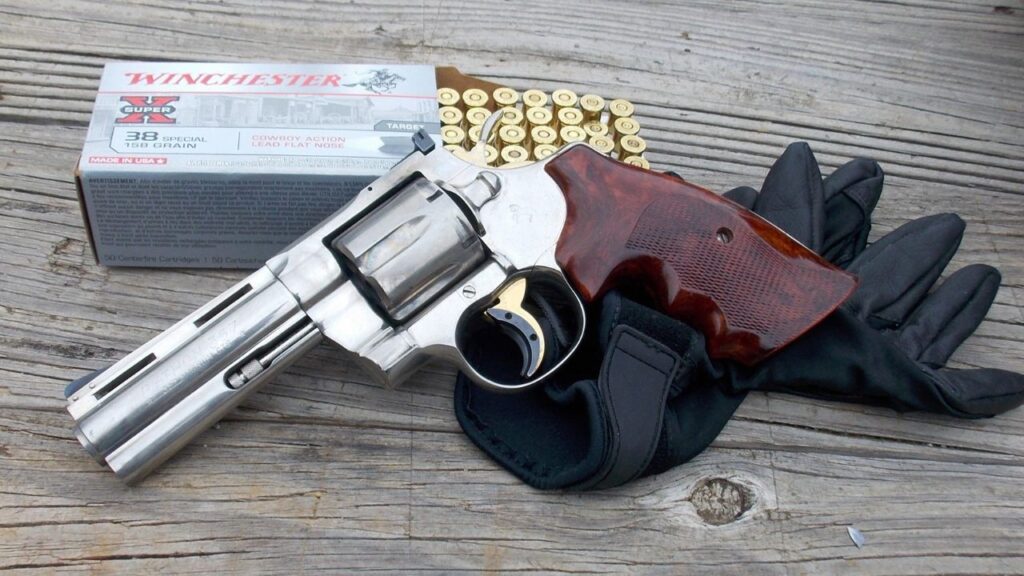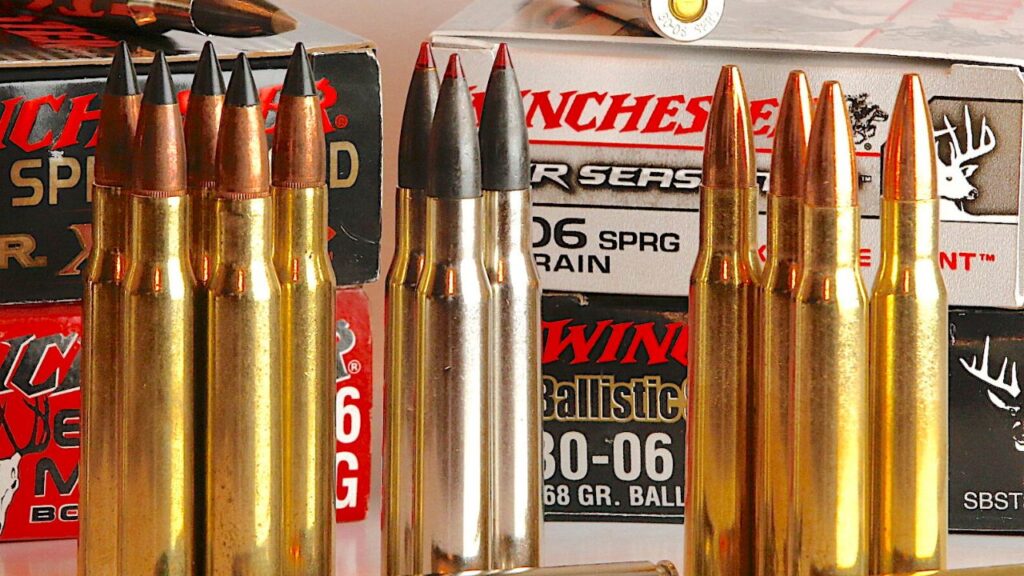Long-range shooting is the pinnacle of marksmanship and requires precision, skill, and a deep learning of the complexities involved in hitting distant targets.
To achieve accuracy in long-range shooting, bullet drop on 30 06 is essential to understand the concept of bullet drop, a fundamental aspect that influences the trajectory of a bullet at extended distances.
In this article, we delve into the world of long-range shooting mastery, specifically focusing on understanding bullet drop with the venerable .30-06 caliber rifle.
The .30-06 cartridge, known for its versatility and performance, has been a staple in the arsenal of hunters, shooters, and military personnel for decades.
Throughout this speech, we will unravel the intricacies of the shot put, explore the nuances of the .30-06 caliber, and equip you with the knowledge and tools necessary to improve your long-range shooting skills.
Join us as we embark on a journey into the realm of precision marksmanship, where every shot is a testament to skill, preparation, and a deep understanding of the dynamics at play. Let’s discover the secrets to master long-range shooting with the .30-06 caliber rifle.
What is Bullet Drop?

Bullet drop refers to a bullet’s downward trajectory as it travels toward its target over an extended distance. When a bullet is fired from a rifle, it follows a curved path influenced by gravity and various environmental factors.
As the bullet travels through the air, it gradually loses height, causing it to fall below the line of sight. The bullet drop phenomenon is a critical consideration for shooters, especially those engaging targets at long ranges.
Understanding and considering bullet drop is essential to achieving accuracy and precision when shooting. Not considering bullet drops can lead to missed targets or inaccurate shots.
Several factors contribute to bullet drop, including bullet velocity, projectile ballistic coefficient, angle of shot, and environmental conditions such as air density, temperature, and wind speed.
Understanding the .30-06 Caliber

The .30-06 caliber rifle has a storied history and remains a favorite among shooters and hunters for its versatility, power and reliability.
Initially developed for military use, the .30-06 cartridge has since found widespread adoption in civilian shooting sports and hunting applications.
The “bullet drop on 30 06” designation represents the caliber (0.30 inch) and the year of its introduction (1906), reflecting its long presence in firearms culture.
The cartridge design features a bottlenecked, rimless casing and is capable of propelling a variety of bullet weights at impressive velocities.
One of the defining characteristics of the bullet drop on 30 06 caliber is its ability to accommodate a wide range of configurations and bullet weights, making it suitable for various shooting tasks.
Whether used for long-range precision shooting, big game hunting, or military applications, the .30-06 rifle offers a potent combination of power and accuracy.
In terms of performance, the .30-06 cartridge features a flat trajectory and high energy, making it effective at long ranges.
270 Vs 30-06 Vs 308 versatility allows shooters to engage targets at various ranges with confidence, making it a popular choice among discerning shooters.
The .30-06 caliber rifle has earned a reputation for reliability and effectiveness in the field, cementing its status as a timeless classic among firearms enthusiasts.
Whether you are an experienced shooter or a novice shooter, the .30-06 rifle offers a platform that combines tradition, performance and practicality, making it a formidable companion in any shooting activity.
Calculating Bullet Drop

Calculating bullet drop is a fundamental aspect of long-range shooting, essential to ensuring accuracy and precision when engaging distant targets. Bullet drop refers to the downward trajectory of a bullet as it travels through the air, influenced by gravity and other environmental factors.
There are several methods for calculating bullet drop, each offering varying degrees of accuracy and complexity. Below are some common approaches used by shooters:
Ballistic Charts and Charts: Many ammunition manufacturers provide ballistic charts and charts detailing the trajectory of their bullets at different distances and velocities.
Federal Champion Training Handgun Ammo 9mm 100-Rounds 115 Grain FMJ tables generally take into account factors such as bullet weight, muzzle velocity, and ballistic coefficient to estimate bullet drop at various ranges.
Ballistic Calculators: Ballistic calculators, available on both handheld devices and smartphone apps, offer a convenient and accurate way to calculate bullet drops for specific shooting conditions.
By inputting data such as bullet characteristics, muzzle velocity, atmospheric conditions, and target distance, shooters can obtain accurate predictions of the bullet’s trajectory and adjust their aim accordingly.
Hand Calculations: For shooters who prefer a hands-on approach, hand calculations involve using mathematical formulas and ballistic principles to estimate bullet drop.
Factors such as bullet weight, muzzle velocity, time of flight, and gravitational acceleration are considered to determine the amount of bullet drop at a given distance.
When calculating bullet drop, environmental variables that can affect bullet trajectory, including air density, temperature, humidity, and wind speed, must be taken into account.
These 300 Win Mag vs 308 factors can significantly influence a bullet’s flight path and may require adjustments to compensate for changes in shooting conditions.
Ultimately, mastering the art of calculating bullet drop requires practice, experimentation, and familiarity with the rifle and ammunition.
By employing accurate measurement tools, leveraging ballistics data, and understanding the principles of ballistics, shooters can hone their long-range shooting skills and consistently deliver accurate shots on target, even at extended ranges.
Ballistic Coefficient (BC) And its Role
The ballistic coefficient (BC) is a crucial parameter in the field of long-range shooting. It plays an important role in predicting the trajectory and performance of a bullet in flight.
In essence, BC quantifies how well a bullet retains its velocity and resists air drag while traveling through the atmosphere.
Defined as the relationship between a bullet’s sectional density and its drag coefficient, the ballistic coefficient provides a standardized measure of a projectile’s aerodynamic efficiency.
Bullets with higher BC values exhibit superior aerodynamic performance, experience less drag, and maintain velocity over longer distances compared to those with lower BC.
Understanding the 338 mag vs 300 mag coefficient is essential for shooters looking to achieve accuracy and consistency at long ranges.
By selecting bullets with higher BCs, shooters can mitigate the effects of air resistance and gravity, resulting in flatter trajectories and better energy retention at downrange.
The role of the ballistic coefficient extends beyond simple trajectory calculations; It also influences other factors, such as wind drift, flight time, and energy transfer at the moment of impact.
Bullets with higher BCs are less susceptible to wind deflection, allowing shooters to maintain accuracy even in difficult wind conditions.
In practical terms, shooters can use ballistic coefficient data to make informed decisions regarding bullet selection, sight adjustments, and debris corrections for various shooting scenarios.
Additionally, advances in ballistics software and calculators have made it easier than ever for shooters to incorporate BC values into their long-range shooting calculations with precision and accuracy.
In summary, the ballistic coefficient serves as a critical metric for evaluating the aerodynamic performance of bullets and predicting their behavior in flight.
By understanding the role of BC and its implications for long-range shooting, shooters can optimize their equipment and techniques to achieve consistent and accurate results on the range and in the range.
Calculating Bullet Drop
In long-range shooting, understanding and accurately calculating bullet drop is critical to achieving accuracy and hitting targets at long ranges. Bullet drop refers to the downward trajectory of a bullet as it travels through the air due to the influence of gravity.
To calculate bullet drop effectively, shooters often rely on ballistic calculators, ballistic tables, or manual calculations. Here’s how each method works:
Ballistic Calculators: Ballistic calculators are advanced tools available in various forms, including smartphone apps and dedicated devices.
Shooters enter specific data such as bullet weight, muzzle velocity, atmospheric conditions (e.g., temperature, altitude, humidity), and target distance.
The ballistic calculator then calculates the trajectory of the bullet and provides any necessary adjustments to compensate for bullet drop, as well as factors such as wind and drift.
Ballistic tables: Many ammunition manufacturers produce ballistic tables that describe the trajectory of their bullets under different conditions.
These tables typically list bullet drop values for specific distances and provide corrections that shooters can apply to their aiming points.
By referencing the appropriate table and adjusting for relevant factors, shooters can account for bullet drops more accurately.
Manual Calculations: Although less common due to the availability of digital tools, shooters can calculate bullet drops manually using mathematical formulas and ballistic principles.
This ballistics for 150 grain 30-06 method involves considering factors such as bullet weight, muzzle velocity, time of flight, gravitational acceleration, and air resistance.
While more labor-intensive, manual calculations can deepen understanding of ballistic principles and help shooters make informed adjustments.
Regardless of the method used, shooters should also consider environmental variables such as airspeed, direction, and density, as these factors can affect bullet trajectory and require additional compensation.
By mastering the art of calculating bullet drop and diligently taking environmental conditions into account, shooters can improve their long-range shooting skills and consistently achieve accurate hits on target, even under difficult circumstances.
Environmental Factors that Affect Bullet Drop
In long-range shooting, understanding and adjusting environmental factors is crucial to accurately predict the bullet’s trajectory and compensate for deviations in aiming. Several environmental variables can significantly affect bullet drop, including:
Air Density: Air density, influenced by altitude, temperature, and humidity, directly affects the resistance a bullet encounters as bullet drop for 150 grain 30 06 travels through the atmosphere.
In denser air, bullets experience greater drag, resulting in greater bullet drop compared to shooting in less dense conditions.
Temperature: Temperature plays a key role in selecting air density: colder temperatures result in denser air, and warmer temperatures result in less dense air.
Shooters should consider temperature variations when calculating bullet drop, as changes in air density can affect the bullet’s flight characteristics.
Altitude: Altitude also affects air density; Higher altitudes typically have lower air pressure and reduced atmospheric density.
Shooters at higher elevations may experience less air resistance and, therefore, less bullet drop compared to shooting at sea level.
Humidity: Humidity, or the quantity of dampness present in the air, can influence air density and atmospheric conditions.
While humidity itself may not directly affect bullet drop, it can correlate with temperature and affect air density, requiring adjustments to compensate for changes in atmospheric conditions.
Wind: Wind speed and direction pose significant challenges for shooters as they cause bullets to deviate from their course and affect their trajectory.
Windage adjustments must be made to counteract the effects of wind drift and maintain accuracy over long distances.
Barometric Pressure: Changes in barometric tension, associated with weather patterns and atmospheric conditions, can influence air density and affect bullet flight.
Shooters must monitor barometric pressure and make adjustments as necessary to compensate for fluctuations in atmospheric pressure.
By meticulously taking these environmental factors into account and adjusting shooting techniques accordingly, shooters can improve their ability to predict and compensate for bullet drops, ensuring consistent and accurate long-range shots in different conditions.
Using tools like ballistic calculators and anemometers can further help shooters make informed decisions and achieve accuracy in their shooting efforts.
Environmental factors that affect bullet drop:
In long-range shooting, understanding and adjusting environmental factors is crucial to accurately predict the bullet’s trajectory and compensate for deviations in aiming. Several environmental variables can significantly affect bullet drop, including:
Air Density: Air density, influenced by altitude, temperature, and humidity, directly affects the resistance a bullet encounters as 30-06 bullet drop 150 grain travels through the atmosphere.
In denser air, bullets experience greater drag, resulting in greater bullet drop compared to shooting in less dense conditions.
Temperature: Temperature plays a key role in choosing air density: colder temperatures result in denser air, and warmer temperatures result in less dense air.
Shooters should consider temperature variations when calculating bullet drop, as changes in air density can affect the bullet’s flight characteristics.
Altitude: Altitude also affects air density; Higher altitudes typically have lower air pressure and reduced atmospheric density. Shooters at higher elevations may experience less air resistance and, therefore, less bullet drop compared to shooting at sea level.
Humidity: Humidity, or the amount of dampness present in the air, can influence air density and atmospheric conditions.
While humidity itself may not directly affect bullet drop, it can correlate with temperature and affect air density, requiring adjustments to compensate for changes in atmospheric conditions.
Wind: Wind speed and direction pose significant challenges for shooters as they cause bullets to deviate from their course and affect their trajectory.
Windage adjustments must be made to counteract the effects of wind drift and maintain accuracy over long distances.
Barometric Pressure: Changes in barometric stress, associated with weather designs and atmospheric conditions, can influence air density and affect bullet flight. Shooters must monitor barometric pressure and make adjustments as necessary to compensate for fluctuations in atmospheric pressure.
Practical Tips for Mastering Long-Range Shooting
Mastering long-range shooting requires a combination of technical skills, mental discipline, and practical experience. Here are some practical tips to improve your long-range shooting proficiency and accuracy:
Understand your equipment: Familiarize yourself with your rifle, optics and ammunition. Understanding your team’s capabilities and limitations is essential to making informed decisions and achieving consistent results.
Practice constantly: Regular practice is key to improving your shooting skills and developing muscle memory. Spend time perfecting your aiming skills, focusing on fundamentals such as breath control, trigger pull, and tracking.
Focus on the fundamentals: Pay attention to the basics of shooting technique, including proper stance, grip, and sight alignment. Mastering these fundamental skills lays the foundation for accurate shooting and allows you to maintain control over your shots.
Learn to read wind and environmental conditions: Wind is one of the most important factors influencing a bullet’s trajectory over long distances.
Develop the 150 grain 30 06 ballistics ability to evaluate wind speed, direction, and other environmental variables to make precise drift adjustments and compensate for wind drift.
Use the proper shooting support: Use stable shooting positions and support systems such as bipods, shooting stands, or sandbags to maintain stability and reduce shooter-induced movement. A stable platform improves accuracy and allows for more consistent shot placement.
Practice mental focus and discipline: Long-range shooting requires mental strength and focus. Stay attentive to the task at hand, visualize your shot location, and maintain a calm, collected mindset to minimize errors and achieve optimal results.
Record and analyze data: Keep detailed records of your shooting sessions, including shot location, scope settings, and environmental conditions.
Analyzing this data lets you identify trends, track your progress, and make informed adjustments to enhance your shooting performance.
Experiment with different loads and bullet types: Explore different ammunition options and bullet weights to find the combination that best suits your shooting style and preferences.
Experimenting with various loads allows you to optimize performance and tailor your equipment to specific shooting scenarios.
Seek training and mentorship: Consider attending shooting courses or seeking guidance from experienced shooters and instructors.
Training programs provide valuable instruction, feedback, and hands-on exercises to help you hone your skills and overcome challenges.
Be Patient and Persistent. Mastering long-range shooting is a journey that requires patience, dedication, and perseverance. Embrace the learning process, be open to constructive feedback and criticism, and remain committed to continuous improvement.
By incorporating these practical tips into your long-range shooting regimen, you will improve your skills, increase your confidence, and achieve greater success when hitting targets at extended ranges.
Remember that mastering long-range shooting is as much a mental discipline as ballistics of 150 grain 30-06 is a technical skill, and consistent practice and perseverance are essential to success.
Case Studies And Examples
Examining case studies and real-life examples of long-range shooting scenarios can offer valuable insights into the principles, challenges, and strategies involved in achieving precision and accuracy at extended ranges. Below are some illustrative examples:
Military Applications: Military snipers often face demanding long-range shooting conditions in combat environments.
Case studies of military engagements can show the importance of factors such as terrain analysis, wind estimation, and target identification in achieving successful long-range shooting under pressure.
Hunting Expeditions: Hunting big game animals over long distances requires careful planning and 30 06 bullet drop at 300 yards execution.
Case studies of hunting expeditions can highlight ethical considerations, shot placement techniques, and equipment choices that contribute to humane and effective long-range hunting practices.
Competitive Shooting Competitions: Long-range shooting competitions provide a platform for sharpshooters to test their skills against challenging shooting ranges and other shooters. A
nalysis of competition results and performance metrics can reveal trends, strategies, and equipment trends among the sport’s best shooters.
Law Enforcement Operations: Law enforcement snipers are often faced with high-risk situations where precision shooting is necessary to neutralize threats and minimize collateral damage.
Police operations case studies can offer insight into the tactics, equipment selection, and training protocols used to execute successful long-range engagements in urban environments.
Personal Shooting Experiences: Sharing personal long-range shooting anecdotes and experiences can provide relatable insights and practical tips for other shooters.
Stories of triumphs, challenges, and lessons learned can inspire others to test their limits and strive for superiority in their shooting activities.
By examining various case studies and examples, shooters can draw valuable lessons, gain insight into the complexities of long-range shooting, and identify strategies to improve their skills and performance in various shooting disciplines.
Conclusion
Mastering long-range shooting, particularly with the 30 06 bullet drop 150 grain, is a journey that requires dedication, knowledge and practice.
Throughout this exploration of understanding bullet drop, zeroing, environmental factors, and practical tips, we have discovered the complexities and challenges associated with precision aiming at extended ranges.
From understanding the fundamentals of bullet trajectory to making precise sight adjustments, shooters must possess a thorough understanding of ballistic principles and equipment capabilities to consistently achieve accurate results.
By using tools such as ballistic calculators, anemometers, and training programs, shooters can hone their skills and overcome the complexities of long-range shooting.
Case studies and examples from military operations, hunting expeditions, competitive shooting competitions, and personal experiences provide valuable insights and inspiration for shooters looking to improve their performance and take on new challenges.
As we conclude this journey, it is essential to stress the importance of patience, perseverance, and continuous learning in the pursuit of mastery.
Long-distance shooting is both a mental discipline and a technical skill, requiring shooters to maintain concentration, adapt to changing conditions, and adopt the path of improvement.
Whether you are an experienced shooter or a novice shooter, the quest to master long-range shooting with the .30-06 caliber rifle is a rewarding endeavor filled with opportunities for growth and achievement.
Through dedication, practice, and commitment to excellence, shooters can unlock their full potential and experience the thrill of hitting targets with pinpoint accuracy at remarkable distances.
So, as you embark on your long-range shooting adventures, remember to stay focused, disciplined, and, above all, enjoy the journey.
FAQ
How much does a 30-06 drop at 100 yards?
Using the Shooter Calculator and the default parameters for a 30-06 Springfield, we found the maximum range to be 5,926 yards, 17,778 feet, or 3.37 miles.
However, if you shoot at the line of sight level and zero at 100 yards, at 1000 yards, you will be 30 feet down. That’s a considerable bullet drop.
How much does a 30-06 bullet drop at 300 yards?
With the rifle still zeroed for 100 yards, the bullet will drop 3.4″ at 200 yards and 13.4″ at 300 yards.



